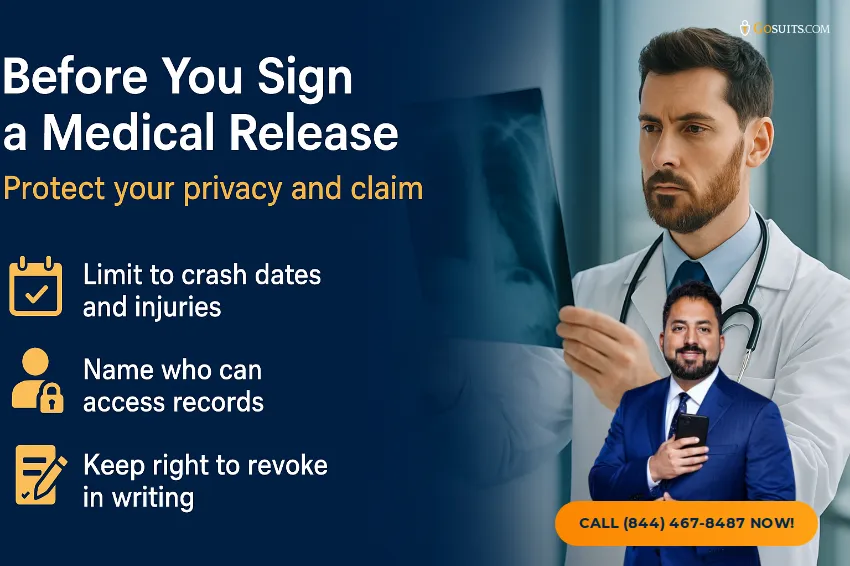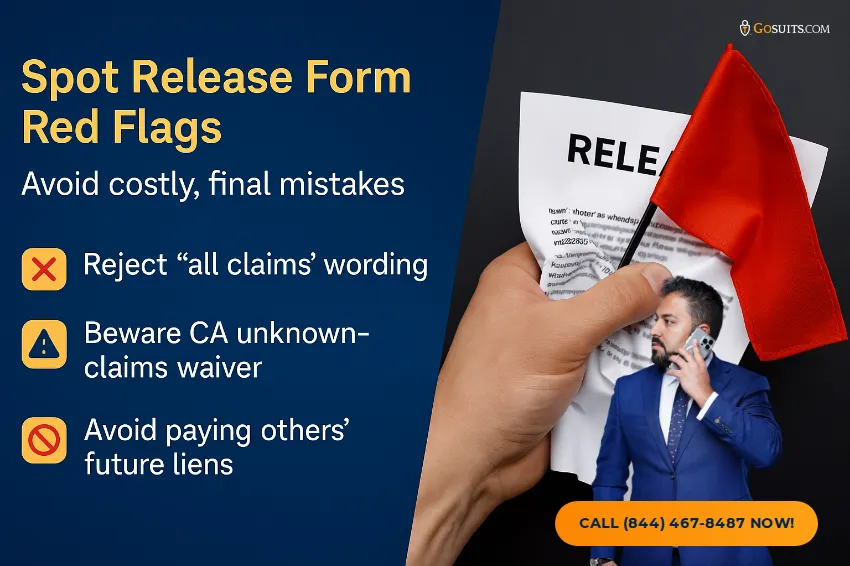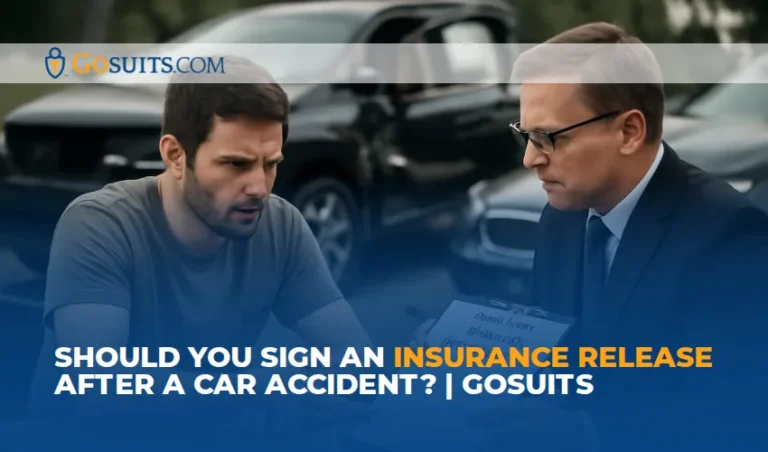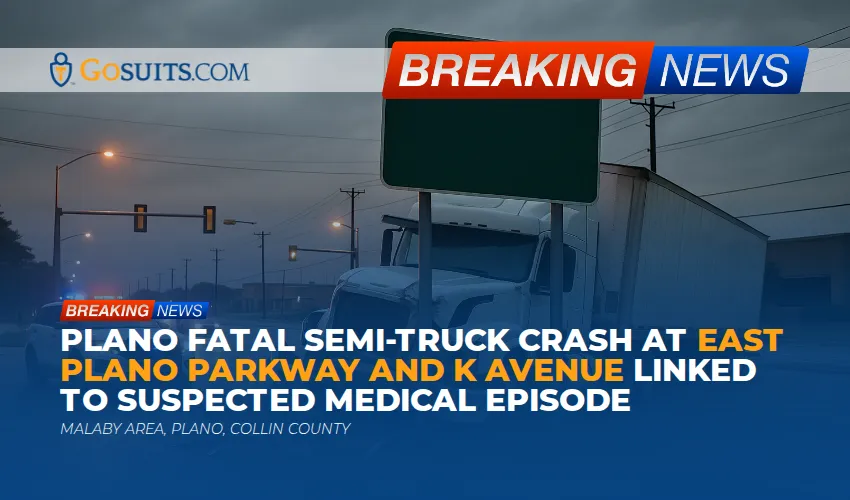- What is an insurance release after a car accident?
- Should you sign a medical authorization the insurer sends?
- When is it safe to sign a settlement release of claims?
- What insurance adjuster tactics should you watch for before signing?
- Do you have to give the insurer a recorded statement?
- How do medical bills, liens, and subrogation affect signing a release?
- What do Texas, California, and Illinois law say about releases, deadlines, and claims?
- How does fault and comparative negligence impact your release and settlement?
- Which insurance forms will you see after a crash and what do they mean?
- What red flags should you look for in an insurance release form?
- How can you protect your rights before signing anything?
- What if you already signed a release or broad authorization?
- What related FAQs do people in TX, CA, and IL ask about insurance releases?
- How can GoSuits help you with an insurance release after a car accident?
- Sources and references
What is an insurance release after a car accident?
After a car accident, the at-fault driver’s insurer or even your own insurer may send you paperwork to sign. The most important of these is often a “release.” In plain terms, a release is a binding contract where you agree to settle your car accident claim for a payment, and in return you give up the right to bring any future claims arising out of that crash. This includes bodily injury claims and, sometimes, property damage, lost wages, and other losses depending on the release wording.
Releases can be narrow or broad. A narrow release might resolve only property damage. A broad release (often titled “General Release” or “Full and Final Release”) can waive all known and unknown bodily injury claims. In California, releases often include a waiver of Civil Code section 1542, which otherwise protects you from releasing unknown claims unless you specifically waive that protection. If you sign a broad release too early, you could unknowingly give up your right to claim compensation for later medical needs or complications.
Under common contract principles, courts generally enforce clear release language. Setting aside a signed release is difficult and usually requires proving fraud, duress, mutual mistake, or similar legal grounds. Because of that, the question is not simply “should you sign,” but “when and what exactly are you signing.”
Should you sign a medical authorization the insurer sends?
Insurers frequently ask injured people to sign a medical authorization form. Many of these are very broad, allowing the insurer to collect years of medical records that are not related to your car crash. Federal privacy rules require that any authorization specify what information will be used and disclosed, its purpose, and an expiration date or event. The HIPAA privacy rule describes the required elements of a valid authorization at 45 C.F.R. 164.508.
Key considerations before signing a medical authorization:
- Scope and time limits – Does it limit records to the date of the crash forward, and to body parts or conditions claimed? Overly broad authorizations can sweep in unrelated, sensitive records.
- Who gets the records – The form should identify the insurer or claim administrator. Vague language that allows disclosure to unspecified third parties is risky.
- Right to revoke – HIPAA authorizations are revocable in writing. The form should state how to revoke.
- Alternatives – Instead of a blanket authorization, you can request, collect, and provide relevant records yourself or through your lawyer. That often protects privacy while keeping the claim moving.
There is generally no legal duty to sign the other driver’s insurer’s medical authorization in a bodily injury claim. Your own policy may require cooperation, but even then, you can usually discuss reasonable limits and process.

When is it safe to sign a settlement release of claims?
Injury symptoms can evolve. It is common for pain to worsen days or weeks after a wreck, and some conditions, such as concussions, disc injuries, or internal injuries, can be missed initially. Once you sign a bodily injury release, your claim is typically over. For that reason, many people wait to settle until they reach maximum medical improvement, have clear medical opinions on prognosis, and understand future care costs.
Signs that it may be premature to sign:
- Ongoing diagnosis – Your physicians are still ordering tests or specialist consults.
- Unresolved symptoms – Pain, mobility limits, or neurological symptoms are not stabilized.
- Future care likely – There is a reasonable chance you will need therapy, injections, or surgery.
- Unclear wage loss – You have not documented lost earnings or reduced capacity.
- Lien questions – Medicare, Medicaid, or health plan repayment issues are not resolved.
On the other hand, settling may make sense when liability is clear, your care is complete, medical bills and liens are known, and the numbers are fully evaluated. If you are in Houston, Dallas, Austin, San Antonio, Los Angeles, San Diego, San Francisco, Sacramento, Chicago, Naperville, or Joliet, the timing strategy can vary based on local provider and court practices.
What insurance adjuster tactics should you watch for before signing?
Adjusters are trained to close files efficiently, which may include quick settlement efforts. Common tactics include:
- Early low offers – A fast settlement offer before your condition stabilizes, often tied to a broad release.
- Broad medical authorizations – Requests for “any and all” medical records for many years pre-accident.
- Recorded statements – Pushing for an on-record interview soon after the crash when you do not have all the facts.
- Suggesting a deadline – Imposing a short response deadline that is not required by law to pressure a decision.
- Minimizing injuries – Attributing symptoms to “preexisting conditions” based on selective records.
Many public regulators address unfair claim practices. For example, Texas Insurance Code chapter 541 prohibits certain unfair settlement practices, and California Insurance Code section 790.03 identifies unfair methods of competition and unfair or deceptive acts or practices in insurance, enforced by the Department of Insurance. Illinois Insurance Code section 154.6 lists improper claims practices. While these laws primarily regulate insurers rather than guarantee private lawsuits in every state, they illustrate what conduct is considered improper and provide context for your interactions.
Do you have to give the insurer a recorded statement?
To the other driver’s insurer, you generally do not have a legal duty to provide a recorded statement. To your own insurer, your policy may include a cooperation clause and a duty to provide information about the loss. Even then, you can usually schedule the statement, prepare it, and limit it to facts you know. Anything you say on a recorded statement can be used to evaluate liability and damages, and, if litigation occurs, may be used for impeachment. As a general rule, statements by a party can be admissible as non-hearsay under the Federal Rules of Evidence 801(d)(2).
Before agreeing to a recorded statement, clarify:
- Scope – Topics and time limits.
- Availability – Wait until you are medically able and have gathered key facts, photos, and police report details.
- Representation – Whether you will have a car accident attorney on the call.
How do medical bills, liens, and subrogation affect signing a release?
Settlements interact with medical payments in several ways:
- Health insurance subrogation – Many health plans seek reimbursement if you recover from a third party. This is common with ERISA-governed plans and private insurers. Your net recovery depends on negotiating or satisfying these claims.
- Medicare – The Medicare Secondary Payer rules require that Medicare not pay when a primary plan should. If Medicare makes conditional payments, it can recover from your settlement. Settlements must address Medicare’s recovery and future interests when applicable.
- Medicaid – State Medicaid programs also have reimbursement rights limited by federal law.
- Provider liens – Hospitals and providers may assert liens for treatment provided. States have specific lien statutes and notice requirements.
Releases sometimes include language about who pays outstanding medical charges. You do not want a surprise where you release the claim but remain responsible for unpaid balances. Before signing the release of claims insurance form, reconcile balances, verify lien amounts, and document how they will be handled from settlement proceeds.
What do Texas, California, and Illinois law say about releases, deadlines, and claims?
What deadlines apply to car accident claims in TX, CA, and IL?
- Texas – Most personal injury claims must be filed within two years of the date of injury, under Texas Civil Practice and Remedies Code section 16.003. There are exceptions, but missing the deadline can bar your claim.
- California – Most injury actions have a two-year statute of limitations from the date of injury, under California Code of Civil Procedure section 335.1. Shorter deadlines can apply to government claims.
- Illinois – Most injury claims must be filed within two years, under 735 ILCS 5/13-202.
These civil deadlines matter when deciding whether to sign a release. Settling too soon may harm you; waiting too long without filing may forfeit your rights. Calendaring the limitations period protects your options.
How do comparative fault rules in TX, CA, and IL affect your settlement release?
- Texas – Texas follows proportionate responsibility. If you are 51 percent or more at fault, you cannot recover. If you are less than 51 percent at fault, your recovery is reduced by your percentage of responsibility, under Chapter 33 of the Texas Civil Practice and Remedies Code.
- California – California applies pure comparative negligence, so your recovery is reduced by your percentage of fault, even if you are more at fault than the other driver. The rule was adopted by the California Supreme Court in Li v. Yellow Cab Co. of California.
- Illinois – Illinois uses modified comparative negligence with a 51 percent bar. If you are more than 50 percent at fault, you cannot recover. If 50 percent or less, your damages are reduced by your share, under 735 ILCS 5/2-1116.
Adjusters use these rules when valuing your claim. Before you sign a settlement release, make sure the fault allocation is based on a full investigation, not just an early recorded statement.
How do unfair claims practices laws influence the process?
- Texas – Texas Insurance Code chapter 541 addresses unfair methods of competition and deceptive acts in the business of insurance, and chapter 542 governs prompt payment of claims. These statutes guide insurer conduct.
- California – California Insurance Code section 790.03 defines unfair practices. While policyholders cannot generally sue third-party insurers under this section, it guides state enforcement. The California Supreme Court’s Moradi-Shalal decision discusses this limitation.
- Illinois – Illinois Insurance Code section 154.6 lists improper claims practices and gives the Department of Insurance enforcement powers.
What about California’s Civil Code section 1542 and unknown claims?
California Civil Code section 1542 protects you from releasing unknown claims unless you expressly waive that protection. Many California settlement release forms include a specific 1542 waiver. Understand that including the waiver means you cannot later claim an unknown injury from the same crash. If you are in Los Angeles, San Diego, San Francisco, or Sacramento, read the 1542 portion carefully before signing.
How does fault and comparative negligence impact your release and settlement?
Because TX, CA, and IL apply comparative fault in different ways, insurers often seek admissions that increase your share of responsibility. A recorded statement or a rushed release can lock in damaging facts. For example, saying “I am fine” at the scene and then later developing symptoms is common, not dishonest, but an insurer may cite it to argue damages are minor. Comprehensive documentation and careful communication help keep the fault and damages evaluation fair before you sign anything final.
Which insurance forms will you see after a crash and what do they mean?
- Property damage release – Resolves only vehicle repair or total loss. It should not waive bodily injury claims. If the form is unclear, request a version expressly limiting the release to property damage.
- Bodily injury release – Waives injury claims in exchange for a sum of money. Confirm whether it is a full and final settlement for all claims. Check any indemnity clause or confidentiality clause.
- Medical authorization – Allows the insurer to obtain medical records. Limit the scope to relevant dates and conditions, or provide records directly.
- Employment or wage authorization – Lets the insurer verify earnings and time off. Consider privacy and scope.
- Recorded statement consent – Authorizes a recorded interview. You can postpone until you have representation and records.
What red flags should you look for in an insurance release form?
- Overly broad language – Phrases like “all claims of any nature, whether known or unknown” tied to a low settlement.
- Section 1542 waiver in CA – A waiver you do not fully understand.
- Indemnity obligations – Language requiring you to pay back the insurer if a lienholder later asserts a claim, without limits.
- Confidentiality and non-disparagement – Clauses that may be unnecessary or overreaching.
- Release of non-parties – Releasing entities or people not contributing to the settlement, which could hamper further recovery.

How can you protect your rights before signing anything?
- Get medical clarity – Reach a stable point in treatment or obtain a physician opinion on future care and prognosis.
- Gather documentation – Save photos, repair estimates, medical bills, diagnostic reports, and wage records.
- Verify liens – Contact Medicare, Medicaid, and health plans as needed. Confirm hospital or provider liens and balances.
- Limit authorizations – Provide targeted records instead of blanket authorizations when possible.
- Calender deadlines – Track statute of limitations for TX, CA, and IL to preserve litigation options if negotiations stall.
- Consult a car accident lawyer – Navigating comparative fault, liens, and release language is technical. A Texas car accident lawyer, a California personal injury attorney, or an Illinois car accident attorney can communicate with adjusters, negotiate the terms, and prepare the release so you do not give up more than intended.
What if you already signed a release or broad authorization?
If you signed a bodily injury release, undoing it is difficult. Potential avenues include showing fraud, duress, or mutual mistake, but those are narrow and fact-specific. If you signed a broad medical authorization, you can often revoke it in writing under HIPAA rules. If an adjuster is still requesting records after revocation, put the revocation in writing and keep proof of delivery.
If you are unsure what you signed in Houston, Dallas, Austin, San Antonio, Los Angeles, San Diego, San Francisco, Sacramento, Chicago, Naperville, or Joliet, request a copy of the signed document and timeline from the insurer. Acting quickly helps, especially if a statute of limitations is approaching.

How can GoSuits help you with an insurance release after a car accident?
You do not have to navigate insurance forms alone. If an adjuster is pushing you to sign an insurance release form after a car accident or a medical authorization insurance packet, we are here to help you protect your rights and make informed choices. Our team supports clients across Texas, California, and Illinois in cities like Houston, Dallas, Austin, San Antonio, Los Angeles, San Diego, San Francisco, Sacramento, Chicago, Naperville, and Joliet.
What availability and communication do we offer?
- Available 24/7 – Speak with an attorney or staff member any time, day or night. We provide immediate free consultations so you can get answers when it matters, including evenings and weekends.
- Responsive updates – We maintain regular communication and provide status updates at each stage, from claim setup to settlement.
- Multilingual support – We provide multilingual customer service, with 24/7 Spanish and Farsi speakers available to make sure you are heard and understood.
What are our fee policies and cost transparency?
- No win, No Attorney Fees – Learn about our approach to fees here: No win, No Attorney Fees.
- No hidden administrative fees – We explain costs clearly at the start and in writing. You will see how case costs are handled and when they apply.
How do our tools and case workflow help your claim?
- Purpose-built injury software – We built proprietary Personal Injury software for our firm that helps us track treatment, organize evidence, and prepare settlement demands efficiently. This improves investigation, negotiation, and, when needed, filing and discovery.
- Data-driven negotiation – We leverage documentation, medical timelines, and comparative fault analysis to present a clear case to insurers, reducing back-and-forth and helping prevent mischaracterization of your injuries.
What is our experience and track record?
- 30 years of combined experience – Our team has handled a wide range of bodily injury claims across TX, CA, and IL.
- 1,000+ litigated matters – We have litigated more than a thousand cases, with settlements and verdicts published on our website. See representative results here: past cases.
- Serious injury capability – In product liability, 18-wheeler, brain and spinal injury, and other complex cases, we retain qualified forensic, medical, and accident reconstruction professionals in the relevant state to establish liability and damages.
- Multi-state litigation – We handle severe injury and complex litigation in Texas, California, and Illinois when a fair resolution requires courtroom action.
- Awards and recognitions – Our attorneys and firm have received recognitions, including Top 100 Settlement in Texas, National Trial Lawyers Top 40 Under 40 for Sean Chalaki, recognition by Best Lawyers in 2023, 2024, and 2025, and Super Lawyers recognition since 2021.
What services do we provide in release and settlement matters?
- Immediate claim setup and evidence preservation – We open claims, safeguard vehicle data and photos, and request body-cam or traffic footage where available.
- Medical coordination – We help you document care accurately and collect complete records without unnecessary disclosure of private, unrelated information.
- Lien resolution – We identify Medicare, Medicaid, and private plan reimbursement issues early and work to resolve them as part of settlement planning.
- Release review and negotiation – We review proposed settlement releases, remove overbroad terms, handle California section 1542 language appropriately, and make sure property and injury claims are not confused.
- Settlement valuation – We assess the full claim value, including comparative fault, future medical care, wage loss, and non-economic harm based on your unique facts.
- Litigation readiness – If needed, we file suit within the statute of limitations and litigate to keep pressure on the insurer to treat your claim fairly.
Where are we located and how can we help immediately?
We serve clients across Texas, California, and Illinois, with attorneys and staff available 24/7 to help. Whether your crash happened in Houston, Dallas, Austin, San Antonio, Los Angeles, San Diego, San Francisco, Sacramento, Chicago, Naperville, or Joliet, we can start with a free consultation, review any release or medical authorization you have been asked to sign, and outline the next steps the same day. Our goal is to remove the pressure so you do not sign away important rights too early.
Community involvement
- Local engagement – We support schools, chambers of commerce, and non-profits in the communities we serve.
- Professional leadership – Our attorneys participate in trial lawyer organizations, including service on boards such as the Texas Trial Lawyers Association, and are active with consumer rights groups.
If you are searching for a car accident lawyer near me in TX, CA, or IL, we are ready to listen, review your documents, and help you make a careful, informed decision about any insurance release or authorization in front of you.
Sources and references
- HIPAA authorizations – 45 C.F.R. 164.508 requirements for valid authorization: https://www.ecfr.gov/current/title-45/subtitle-A/subchapter-C/part-164/subpart-E/section-164.508
- Medicare Secondary Payer program overview: https://www.cms.gov/medicare/coordination-benefits-recovery/medicare-secondary-payer
- Federal Rules of Evidence 801, definitions and admissions by a party-opponent: https://www.law.cornell.edu/rules/fre/rule_801
- Texas statute of limitations, personal injury – Tex. Civ. Prac. & Rem. Code § 16.003: https://statutes.capitol.texas.gov/Docs/CP/htm/CP.16.htm#16.003
- Texas proportionate responsibility – Tex. Civ. Prac. & Rem. Code ch. 33: https://statutes.capitol.texas.gov/Docs/CP/htm/CP.33.htm
- Texas Insurance Code, unfair settlement practices – ch. 541: https://statutes.capitol.texas.gov/Docs/IN/htm/IN.541.htm
- Texas Insurance Code, prompt payment – ch. 542: https://statutes.capitol.texas.gov/Docs/IN/htm/IN.542.htm
- California statute of limitations, personal injury – CCP § 335.1: https://leginfo.legislature.ca.gov/faces/codes_displaySection.xhtml?sectionNum=335.1.&lawCode=CCP
- California comparative negligence – Li v. Yellow Cab Co. of California, 13 Cal. 3d 804 (1975): https://www.courtlistener.com/opinion/1182133/li-v-yellow-cab-co-of-california/
- California Civil Code § 1542 (unknown claims): https://leginfo.legislature.ca.gov/faces/codes_displaySection.xhtml?sectionNum=1542.&lawCode=CIV
- California Insurance Code § 790.03 (unfair practices): https://leginfo.legislature.ca.gov/faces/codes_displaySection.xhtml?sectionNum=790.03.&lawCode=INS
- Moradi-Shalal v. Fireman’s Fund Insurance Companies, 46 Cal.3d 287 (1988): https://www.courtlistener.com/opinion/1181378/moradi-shalal-v-firemans-fund-insurance-companies/
- Illinois statute of limitations, personal injury – 735 ILCS 5/13-202: https://www.ilga.gov/legislation/ilcs/fulltext.asp?DocName=073500050K13-202
- Illinois modified comparative fault – 735 ILCS 5/2-1116: https://www.ilga.gov/legislation/ilcs/fulltext.asp?DocName=073500050K2-1116
- Illinois improper claims practices – 215 ILCS 5/154.6: https://www.ilga.gov/legislation/ilcs/fulltext.asp?DocName=021500050K154.6
- Internal Revenue Code § 104(a)(2) – exclusion for personal injury damages: https://www.law.cornell.edu/uscode/text/26/104
FAQs
Can I settle property damage now and injury later?
Yes, you can. Ask for a property-damage-only release. Make sure the release expressly preserves bodily injury claims.
Do I have to use the insurer’s medical authorization form?
No. You can offer to provide relevant records directly or sign a narrower form that limits date ranges and providers to crash-related care. HIPAA requires specific elements for authorizations, and you can revoke authorizations in writing.
What happens if I waive California Civil Code section 1542?
A 1542 waiver means you are releasing unknown claims arising out of the crash. If a later injury is discovered, you may be barred from pursuing it. Do not waive section 1542 without understanding the risks and settlement value.

Will the IRS tax my car accident settlement?
Generally, compensation for personal physical injuries is excluded from gross income under Internal Revenue Code section 104(a)(2). Portions allocated to interest or non-physical injury damages can be taxable. Tax treatment can be complex, so consider speaking with a tax professional about your specific situation.
What is a recorded statement and should I give one?
A recorded statement is a formal interview the insurer records. You do not usually have to give one to the other driver’s insurer. To your own insurer, your policy may require cooperation. If you give one, prepare carefully and consider having counsel present.
Can a release be set aside if the adjuster misled me?
Courts can set aside a release for fraud or certain unfair practices, but proving it can be difficult. Keep all emails, letters, and notes of conversations. Consumer protection and insurance codes in TX, CA, and IL regulate insurer behavior, though the right to sue a third-party insurer directly is limited in some states.
What statistics show why timing matters?
Crashes are a leading cause of serious injury in the United States. Federal data show that motor vehicle injuries and fatalities remain a significant public health concern each year. This underscores why waiting until injuries are understood and documented can be critical before signing away rights in a settlement.






